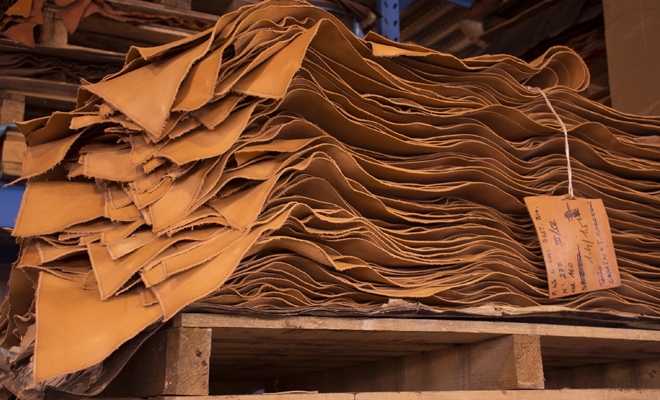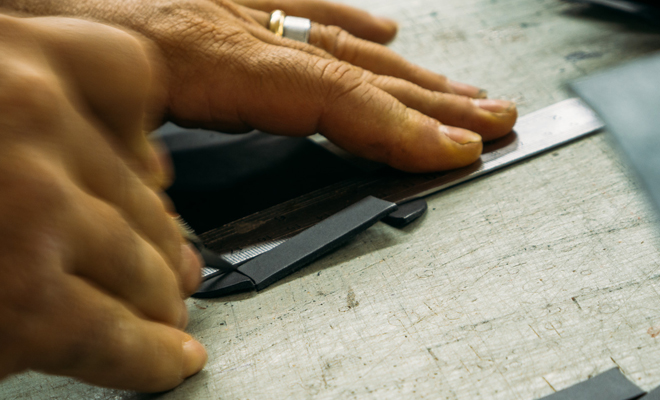How To :: Identify Superior Leather with Oppermann London
Leather is one of the oldest materials made by humans, and quite naturally, many techniques of making leather have been developed. As makers of leather bags and accessories we have come across many types of leather, but finding and identifying high quality leather is not the easiest of tasks. We would like to share with you some tips and insights we have learned over the years.
1. Identify leather origin
This can be tricky as a consumer, but it is worth asking the brand where their tannery sourced their raw hides. If a hide is intended to become a high quality vegetable-tanned leather, a rule of thumb is that hides from cattle living in a cold climate will usually end up as a higher quality leather compared to hides from warmer climates.
“This can be tricky as a consumer, but it is worth asking the brand where their tannery sourced their raw hides”
That is because the cold environment exposes the animal to less damaging insects than warm environments and the cold climate creates a tighter and more robust hide. However, cattle from Scandinavia are usually also living in an environment where they are less likely to damage their hides and live a better life due to higher standards of animal rights regulations.
2. Vegetable-tanned vs. Chrome-tanned leather
There are many ways to tan leather, but the most widely used are chrome-tanned and vegetable-tanned leather. The difference between chrome and vegetable tanning is the way the moisture is extracted from the raw hides. In chrome tanning this is done using chemical compounds (chromium based) while a vegetable-tanning process uses only natural ingredients.
“The difference between chrome and vegetable tanning is the way the moisture is extracted from the raw hides”
The majority of the leather produced is chrome-tanned (80-90%), but the finest leather goods are made with vegetable-tanned leather. Vegetable-tanned leather is preferred for leather goods because it’s perceived to be better for the environment, it’s highly durable and it has the ability to develop a beautiful patina.
There are two simple tests you can try to determine whether the leather is chrome, or vegetable-tanned. Usually a chrome-tanned leather looks more synthetic, smells less organic and feels more flimsy compared to vegetable-tanned leather, but sometimes telling them apart can be tricky.
“There are two simple tests you can try to determine whether the leather is chrome, or vegetable-tanned”
Test 1: Put a small narrow strip of leather in boiling water. If the leather instantly curls up, it is vegetable-tanned. A chrome-tanned leather will just float around in water.
Test 2: Burn a piece of leather with a lighter. If you have a vegetable-tanned leather, it will not burn in flames and the ashes will be grey or black. A chrome-tanned leather will burn more easily and its ashes are green.

3. Make sure your leather is full grain
When a hide arrives at the tannery it is around 2cm thick. This is split into several layers which are sold as different types of leather. It is the outmost layer, just below the hair, that we are after and this is called the full grain. Full grain leather is the strongest, most durable leather and the only part that will develop a beautiful patina over time.
“To identify full grain leather you need to look closely at the surface for ‘the grain’”
To identify full grain leather you need to look closely at the surface for ‘the grain’ (pores) of the leather, this is where the hair once grew. A magnifying glass could help at this stage. If you see these small pores looking like small craters, then you have found a full grain leather.

If the surface is completely smooth and lacks a natural structure, you have what is called a corrected grain or a lower layer split. On a corrected grain the top layer (a couple of mm) has been removed by sanding and buffing to remove imperfections. The corrected grain is often used for cheaper leather goods and is nowhere near the full grain leather in terms of durability.
4. Learn about the tannery
Each tannery has its own secret recipe on how to make the perfect leather and there are plenty of tanneries who make excellent leather. For the fine details such as the touch and smell between high quality leathers it often comes down to an individual preference on which is more desirable.

At Oppermann we have full supplier transparency, which means we show where our leathers are sourced (as well as all other components). Even if most brands may not show their suppliers, we believe it’s a good idea asking in which country it’s been tanned and from where the raw hide originates. If a product, for example, is made in Italy, it does not mean that the leather is Italian.
“At Oppermann we have full supplier transparency, which means we show where our leathers are sourced”
If you can find the specific tannery that made the leather, you are in a good position to judge its quality. They usually have lots of information on their websites about their history, customers and their methods and procedures.

5. Do market research
Doing plenty of market research is always helpful. Visit stores which sell very cheap leather goods (Primark, H&M etc.) as well as the very top end (Hermès for example) and everything in between. By creating your individual leather quality benchmarks, you will be in a good position to judge leather quality in the middle price segment. This is important because it is the middle segment that is the trickiest. There are many brands that are selling similar products at similar prices, but are differentiating significantly in quality.
To read about the tanneries we work with, have a look at our factories page.
*Written by Mattis Oppermann, Co-Founder and Manager at Oppermann London.
–
[*Ed note: It’s important to understand your intended use before you can really judge whether Vegetable tanned or Chrome leathers will be better. Vegetable tanned leathers are generally stiffer and less elastic, change character more with age, and generally don’t deal well with moisture. That means if you want gloves or hiking boots, go with Chrome tanned every time.
There are superb leathers in both Chrome and Veg methods, and under well controlled conditions, our research says that neither is really better for the environment. Leather Working Group has excellent research in this area if you are interested.]
*Editor’s Note: Oppermann London has now rebranded to Carl Friedrik.





 Carry Awards
Carry Awards Insights
Insights Liking
Liking Projects
Projects Interviews
Interviews


















